
Galls or cecidia are a kind of swelling growth on the external tissues of plants, fungi, or animals. Plant galls are abnormal outgrowths of plant tissues, similar to benign tumors or warts in animals. They can be caused by various parasites, from viruses, fungi and bacteria, to other plants, insects and mites. Plant galls are often highly organized structures so that the cause of the gall can often be determined without the actual agent being identified. This applies particularly to some insect and mite plant galls. The study of plant galls is known as cecidology.

Ficus macrophylla, commonly known as the Moreton Bay fig or Australian banyan, is a large evergreen banyan tree of the Mulberry Family (Moraceae) native to eastern Australia, from the Wide Bay–Burnett region in the north to the Illawarra in New South Wales, as well as Lord Howe Island where the subspecies F. m. columnaris is a banyan form covering 2.5 acres or more of ground. Its common name is derived from Moreton Bay in Queensland, Australia. It is best known for its imposing buttress roots.
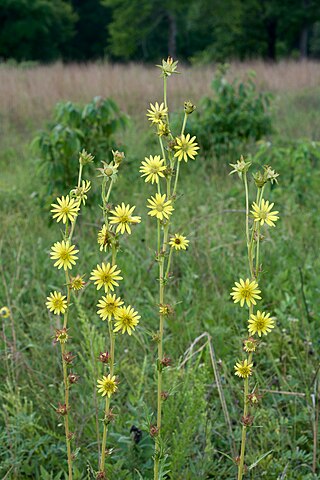
Silphium laciniatum is a species of flowering plant in the family Asteraceae known commonly as compassplant or compass plant. It is native to North America, where it occurs in Ontario in Canada and the eastern and central United States as far west as New Mexico. Other common names include prairie compass plant, pilotweed, polarplant, gum weed, cut-leaf silphium, and turpentine plant. It is a rosinweed of genus Silphium.

Rosa nutkana, the Nootka rose, bristly rose, or wild rose is a 0.6–3.0-metre-tall (2–10-foot) perennial shrub in the rose family (Rosaceae).

Solidago canadensis, known as Canada goldenrod or Canadian goldenrod, is an herbaceous perennial plant of the family Asteraceae. It is native to northeastern and north-central North America and often forms colonies of upright growing plants, with many small yellow flowers in a branching inflorescence held above the foliage. It is an invasive plant in other parts of the continent and several areas worldwide, including Europe and Asia. It is grown as an ornamental in flower gardens.

Rosa pisocarpa is a species of rose known by the common name cluster rose or swamp rose. It is native to western North America from British Columbia to northern California, where it generally grows in moist habitats. It is a shrub sometimes forming a thicket, and growing up to 2.5 meters tall. The stems can be dark red or blackish and are often studded with straight, paired prickles at nodes. The leaves are each made up of several toothed oval leaflets, the terminal leaflet up to 4 centimeters long. The inflorescence is a cyme of up to 10 flowers with pink petals each up to 2 centimeters in length. The fruit is a rose hip about a centimeter wide. The hips are pear- or egg-shaped and borne in clusters, and are decorative in fall and early winter, when they are red or reddish-purple and contrast with yellow foliage. Fall foliage can be yellow or dark red.

Cassytha filiformis or love-vine is an orangish, wiry, parasitic vine in the family Lauraceae. It is found in coastal forests of warm tropical regions worldwide including the Americas, Indomalaya, Australasia, Polynesia and tropical Africa.

Cynipini is a tribe of gall wasps. These insects induce galls in plants of the beech and oak family, Fagaceae. They are known commonly as the oak gall wasps. It is the largest cynipid tribe, with about 936 to 1000 recognized species, most of which are associated with oaks. The tribe is mainly native to the Holarctic. Cynipini wasps can act as ecosystem engineers. Their galls can become hosts of inquilines, and the wasps themselves are hosts to parasitoids.

Andricus quercuscalifornicus, or the California gall wasp, is a small wasp species that induces oak apple galls on white oaks, primarily the valley oak but also other species such as Quercus berberidifolia. The California gall wasp is considered an ecosystem engineer, capable of manipulating the growth of galls for their own development. It is found from Washington, Oregon, and California to northern regions of Mexico. Often multiple wasps in different life stages occupy the same gall. The induced galls help establish complex insect communities, promoting the diversification in niche differentiation. Furthermore, the adaptive value of these galls could be attributed their ecological benefits such as nutrition, provision of microenvironment, and enemy avoidance.
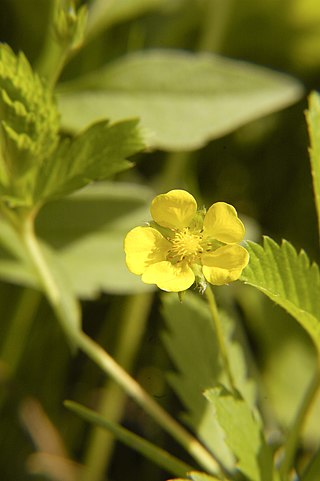
Potentilla simplex, also known as common cinquefoil or old-field five-fingers or oldfield cinquefoil, is a perennial herb in the Rosaceae (rose) family native to eastern North America from Ontario, Quebec, and Labrador south to Texas, Alabama, and panhandle Florida.
Andricus opertus, the fimbriate gall wasp, is a species of wasp in the family Cynipidae whose bisexual generation induces elongate, spiky galls on the leaves of various species of oaks in California, including valley oak and scrub oak. The galls of the bisexual generation form in spring, adults emerge in late spring, and galls persist on trees until the fall. The unisexual generation of this species forms aborted bud galls in the summer and fall.
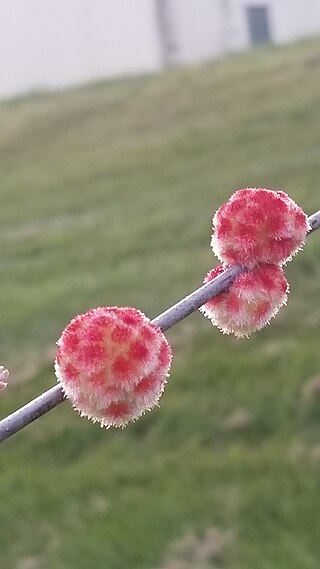
Callirhytis seminator, the wool sower, is a species of gall wasp in the family Cynipidae.
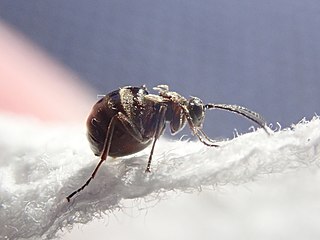
Acraspis quercushirta, the jewel oak gall wasp, is a species of gall wasp in the family Cynipidae, tribe Cynipini, found in North America.
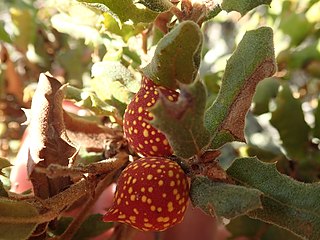
Burnettweldia is a genus of oak gall wasps in the Nearctic.

Burnettweldia plumbella, also known as the beaked twig gall wasp, is a species of gall wasp. Previously in the genus Disholcaspis, it was moved into a new genus, Burnettweldia, in 2021. This wasp induces galls on oak trees, including blue oak, leather oak, Muller's oak, and scrub oaks. The galls are up to 15 mm in diameter and brightly colored, coming in either red with yellow spots or green with yellow spots. Their name comes from the galls' pointed tip. Galls are formed in spring and summer, and adults emerge from them in November and December. The adult wasps are 3–4 mm in length.

Acraspis guadaloupensis is a relatively uncommon species of cynipid wasp that produces galls on intermediate oaks. The intermediate oak disc wasp was first described in 1911 and has been moved between genera more than once. Distribution is limited to California in North America. The flattened galls appear on leaves of Quercus chrysolepis, the canyon live oak.
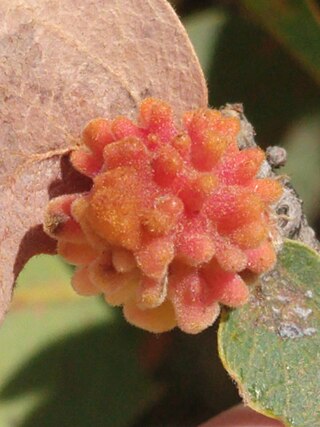
Burnettweldia corallina, formerly Disholcaspis corallina, the coral gall wasp, is a species of hymenopteran that induces galls on blue oaks in California in North America. The wasp oviposits at the base of leaf petioles. The detachable galls start out a mottled red-orange-yellow and over time darken to a deep brown and become brittle. This gall superficially resembles the oak galls induced by Besbicus heldae and Cynips quercusechinus.
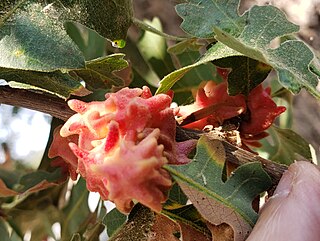
Besbicus heldae, formerly Cynips heldae, also known as the thorny gall wasp or thorn gall wasp, is an uncommon species of cynipid wasp that induces bud galls on Oregon oak and valley oak trees on the west coast of North America. Fresh gall are rose pink, measure 6–16 mm in diameter, and have a "mealy-granular" surface and possibly overlapping, disorderly looking "spikes". Galls are detachable and turn brown as they age. This gall superficially resembles the galls induced by Burnettweldia corallina or Cynips quercusechinus.
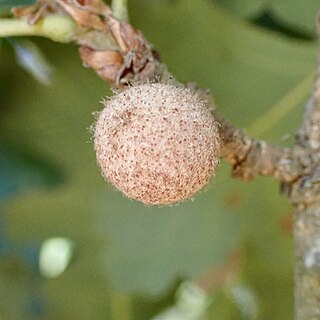
Burnettweldia washingtonensis, formerly Disholcaspis washingtonensis, the fuzzy gall wasp, is a species of hymenopteran that induces stem galls on white oaks on the Pacific coast of North America. The detachable galls have a little stem or neck, are gray or beige and fuzzy, and measure about 8–10 mm in diameter. The larval chamber is located at the center of the ball, the interior of which is otherwise chocolate brown. Older galls may appear pitted. The locally common galls induced by this wasp are sometimes mistaken for the galls induced by Besbicus conspicuus.
















